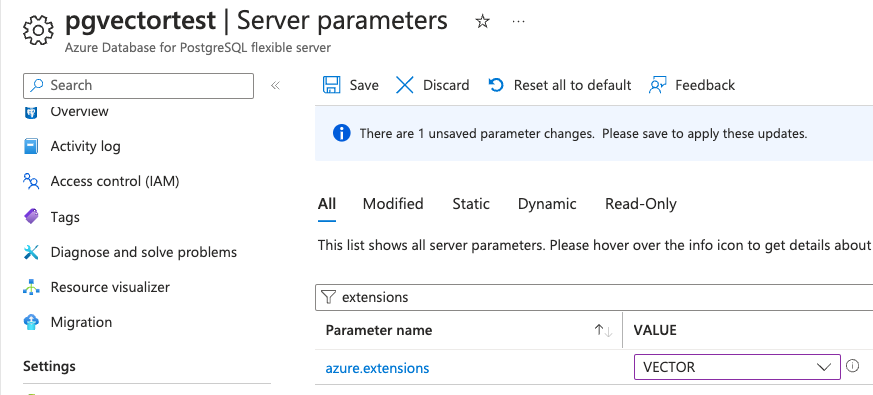Easily deploy a pgvector-enabled PostgreSQL server to Azure

The pgvector extension was first released in 2021 but has shot up in popularity in the last year, as developers discover what is possible with vector embeddings, vector similarity, and vector search. Once we start storing embedding vectors in database rows, we can make queries like "which movies are more similar to each other, based on their synopsis?" and "which retail item's descriptions most closely match this user's query?"
What is pgvector?
The pgvector extension allows PostgreSQL users to store columns of a vector type, create an index (HNSW or IVF) to efficiently index the vector fields, and query using vector distance operators (cosine, Euclidean, or inner product). Or, to put that in SQL form:
Note: While the extension is typically referred to as "pgvector", the actual extension name is "vector", so that is what's used in the CREATE EXTENSION statement above.
Using pgvector on Azure PaaS
Azure now has multiple PaaS offerings for PostgreSQL that support the pgvector extension: PostgreSQL Flexible Server and Azure Cosmos DB PostgreSQL server.
If you already have an existing Azure PostgreSQL server, you can enable the extension manually in the Portal, as shown below and described in the linked tutorials.
A PostgreSQL flexible server with pgvector extension enabled.
An easy template for pgvector deployment
To make it even easier to get started with pgvector on PostgreSQL Flexible Server, we've created a template project that contains infrastructure-as-code (Bicep files) and support for the Azure Developer CLI (azd). Clone or download the project here:
https://github.com/Azure-Samples/azure-postgres-pgvector-python
With a few commands, you'll have a pgvector-enabled PostgreSQL server provisioned in your Azure account. We've also added keyless authentication to the template, so you can authenticate with your Azure credential instead of a secret.
The template project includes multiple Python scripts showing you how to connect to your PostgreSQL server and use the pgvector extension in the most common SQL packages: psycopg2, asyncpg, SQLAlchemy, and SQLModel.
For example, here's a selection of the code from a SQLAlchemy example for storing movie titles and their embeddings:
See the full code in the repository.
There are so many ways that you can use the pgvector extension once you've gotten started with it, both as a tool in building generative AI applications (especially RAG apps), but also in any situation where similarity is a heuristic, like recommendations, fraud detection, and more. Start bringing vectors into your apps today and let us know what you build!
Published on:
Learn moreRelated posts
Automating Business PDFs Using Azure Document Intelligence and Power Automate
In today’s data-driven enterprises, critical business information often arrives in the form of PDFs—bank statements, invoices, policy document...
Azure Developer CLI (azd) Dec 2025 – Extensions Enhancements, Foundry Rebranding, and Azure Pipelines Improvements
This post announces the December release of the Azure Developer CLI (`azd`). The post Azure Developer CLI (azd) Dec 2025 – Extensions En...
Unlock the power of distributed graph databases with JanusGraph and Azure Apache Cassandra
Connecting the Dots: How Graph Databases Drive Innovation In today’s data-rich world, organizations face challenges that go beyond simple tabl...
Azure Boards integration with GitHub Copilot
A few months ago we introduced the Azure Boards integration with GitHub Copilot in private preview. The goal was simple: allow teams to take a...
Microsoft Dataverse – Monitor batch workloads with Azure Monitor Application Insights
We are announcing the ability to monitor batch workload telemetry in Azure Monitor Application Insights for finance and operations apps in Mic...
Copilot Studio: Connect An Azure SQL Database As Knowledge
Copilot Studio can connect to an Azure SQL database and use its structured data as ... The post Copilot Studio: Connect An Azure SQL Database ...
Retirement of Global Personal Access Tokens in Azure DevOps
In the new year, we’ll be retiring the Global Personal Access Token (PAT) type in Azure DevOps. Global PATs allow users to authenticate across...
Azure Cosmos DB vNext Emulator: Query and Observability Enhancements
The Azure Cosmos DB Linux-based vNext emulator (preview) is a local version of the Azure Cosmos DB service that runs as a Docker container on ...

